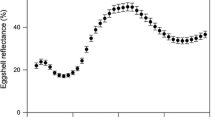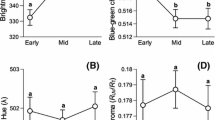Abstract
Although evidence is accumulating on the adaptive function of female ornamentation, very little is known about maternal allocation decisions involving sexual signaling and other reproductive functions. Blue egg coloration has been suggested as a sexually selected signal of female quality to males, and some recent studies are in accordance with this hypothesis. Blue eggshell coloration results from the deposition of biliverdin pigment by laying females, which is a potent antioxidant. Thus, egg pigmentation should be costly in terms of antioxidants, an assumption of the signaling hypothesis that has not been tested yet. We induced increased reproductive effort in a set of female pied flycatchers Ficedula hypoleuca through nest removal and measured egg pigmentation and plasma antioxidant levels in relation with a control group. Experimental females showed a negative association between egg color and plasma antioxidant levels, while there was no relationship for control birds. This supports that egg pigmentation is costly in terms of general antioxidant defenses and suggests a tradeoff between the allocations to both traits. Furthermore, experimental females with more colorful eggs raised more fledglings, especially when breeding early. Controls did not show a relationship between egg color and reproductive success. Females laying more colorful eggs could have shifted their allocation decisions towards current reproduction, at the expense of their own antioxidant defenses. Our results highlight that blue egg coloration is a life-history trait, subject to tradeoffs with other attributes, and seems to be especially informative under harsh breeding conditions.


Similar content being viewed by others
References
Alonso-Álvarez C, Bertrand S, Devevey G, Prost J, Faivre B, Sorci G (2004) Increased susceptibility to oxidative stress as a proximate cost of reproduction. Ecol Lett 7:363–368
Alonso-Álvarez C, Bertrand S, Devevey G, Prost J, Faivre B, Chastel O, Sorci G (2006) An experimental manipulation of life-history trajectories and resistance to oxidative stress. Evolution 60:1913–1924
Amundsen T (2000) Why are female birds ornamented? Trends Ecol Evol 15:149–155
Bertrand S, Alonso-Álvarez C, Devevey G, Faivre B, Prost J, Sorci G (2006) Carotenoids modulate the trade-off between egg production and resistance to oxidative stress. Oecologia 147:576–584
Blount JD, Surai PF, Nager RG, Houston DC, Møller AP, Trewby ML, Kennedy MW (2002) Carotenoids and egg quality in the lesser black-backed gull Larus fuscus: a supplemental feeding study of maternal effects. Proc R Soc Lond B 269:29–36
Bonduriansky R (2001) The evolution of male mate choice in insects: a synthesis of ideas and evidence. Biol Rev 76:305–339
Bonneaud C, Mazuc J, Chastel O, Westerdahl H, Sorci G (2004) Terminal investment induced by immune challenge and fitness traits associated with major histocompatibility complex in the house sparrow. Evolution 58:2823–2830
Burley N (1986) Sexual selection for aesthetic traits in species with biparental care. Am Nat 127:415–445
Chenoweth SF, Doughty P, Kokko H (2006) Can non-directional male mating preferences facilitate honest female ornamentation? Ecol Lett 9:179–184
Cunningham EJA, Birkhead TR (1998) Sex roles and sexual selection. Anim Behav 56:1311–1321
Dawkins R (1982) The extended phenotype. Oxford University Press, Oxford
de Neve L, Soler JJ (2002) Nest-building activity and laying date influence female reproductive investment in magpies: an experimental study. Anim Behav 63:975–980
Doutrelant C, Grégoire A, Grnac N, Gómez D, Lambrechts MM, Perret P (2008) Female coloration indicates female reproductive capacity in blue tits. J Evol Biol 21:226–233
Erel O (2004) A novel automated direct measurement method for total antioxidant capacity using a new generation, more stable ABTS radical cation. Clin Biochem 37:277–285
Falchuk KH, Contin JM, Dziedzic TS, Feng ZL, French TC, Heffron GJ, Montorzi M (2002) A role for biliverdin IX alpha in dorsal axis development of Xenopus laevis embryos. Proc Nat Acad Sci U S A 99:251–256
Fargallo JA, de León A, Potti J (2001) Nest-maintenance effort and health status in chinstrap penguins Pygoscelis antarctica: the functional significance of stone provisioning behaviour. Behav Ecol Sociobiol 50:141–150
Florczyk UM, Jozkowicz A, Dulak J (2008) Biliverdin reductase: new features of an old enzyme and its potential therapeutic significance. Pharmacol Rep 60:38–48
Grether GF, Kolluru GR, Quiroz MA, Robertson G, Snyder AJ (2008) Maternal effects of carotenoid consumption in guppies (Poecilia reticulata). Funct Ecol 22:294–302
Griffith SC (2000) A tradeoff between reproduction and condition-dependent sexually selected ornament in the house sparrow Passer domesticus. Proc R Soc London B 267:1115–1119
Hartley RC, Kennedy MW (2004) Are carotenoids a red herring in sexual display? Trends Ecol Evol 19:353–354
Kaur H, Hughes MN, Green CJ, Naughton P, Foresti R, Motterlini R (2003) Interaction of bilirubin and biliverdin with reactive nitrogen species. Febs Lett 543:113–119
Kennedy GY, Vevers HG (1976) A survey of avian eggshell pigments. Comp Biochem Physiol B 55:117–123
Kokko H (2001) Fisherian and ‘good genes’ benefits of mate choice: how (not) to distinguish between them. Ecol Lett 4:322–326
Kraaijeveld K, Kraaijeveld-Smit FJL, Komdeur J (2007) The evolution of mutual ornamentation. Anim Behav 74:657–677
Krist M, Grim T (2007) Are blue eggs a sexually selected signal of female collared flycatchers? a cross-fostering experiment. Behav Ecol Sociobiol 61:863–876
LeBas N (2006) Female finery is not for males. Trends Ecol Evol 21:170–173
Lens L, Wauters LA, Dhondt AA (1994) Nest-building by crested tit Parus cristatus males—an analysis of costs and benefits. Behav Ecol Sociobiol 35:431–436
López-Rull I, Celis P, Gil D (2007) Egg colour covaries with female expression of a male ornament in the spotless starling (Sturnus unicolor). Ethology 113:926–933
Lundberg A, Alatalo RV (1992) The Pied Flycatcher. Poyser, London
Maines MD (2003) Bile pigments: newcomers to the cell signaling area. Toxicol Sci 71:9–10
Maines MD (2005) New insights into biliverdin reductase functions: linking heme metabolism to cell signaling. Physiology 20:382–389
McDonagh AF (2001) Turning green to gold. Nat Struct Biol 8:198–200
Miksik I, Holan V, Deyl Z (1996) Avian eggshell pigments and their variability. Comp Biochem Physiol 113B:607–612
Morales J, Sanz JJ, Moreno J (2006) Egg colour reflects the amount of yolk maternal antibodies and fledging success in a songbird. Biol Lett 2:334–336
Moreno J, Osorno JL (2003) Avian egg colour and sexual selection: does eggshell pigmentation reflect female condition and genetic quality? Ecol Lett 6:803–806
Moreno J, Osorno JL, Morales J, Merino S, Tomás G (2004) Egg colouration and male parental effort in the pied flycatcher Ficedula hypoleuca. J Avian Biol 35:300–304
Moreno J, Morales J, Lobato E, Merino S, Tomás G, Martínez-de la Puente J (2005) Evidence for the signaling function of egg color in the pied flycatcher Ficedula hypoleuca. Behav Ecol 16:931–937
Moreno J, Morales J, Lobato E, Merino S, Tomás G, Martínez-de la Puente J (2006a) More colorful eggs induce a higher relative paternal investment in the pied flycatcher Ficedula hypoleuca: a cross-fostering experiment. J Avian Biol 37:555–560
Moreno J, Lobato E, Morales J, Merino S, Tomás G, Martínez de la Puente J, Sanz JJ, Mateo R, Soler JJ (2006b) Experimental evidence that egg color indicates female condition at laying in a songbird. Behav Ecol 17:651–655
Moreno J, Lobato E, Morales J, Merino S, Martínez de la Puente J, Tomás G (2008a) Pre-laying nutrition mediates maternal effects on offspring immune capacity and growth in the pied flycatcher. Oecologia 156:727–735 doi:10.1007/s00442-008-1029-7
Moreno J, Martínez J, Corral C, Lobato E, Merino S, Morales J, Martínez-de la Puente J, Tomás G (2008b) Nest construction rate and stress in female pied flycatchers Ficedula hypoleuca. Acta Ornithologica 43:57–64
Partridge L, Sibly R, Beverton RJK, Hill WG (1991) Constraints in the evolution of life histories. Phil Trans R Soc Lond B 332:3–13
Pérez C, Velando A, Lores M (2008) Red coloration signals antioxidant availability in the Yellow-Legged Gull. Behav Ecol, in press
Siefferman L, Navara KJ, Hill GE (2006) Egg colouration is associated with female condition in eastern bluebirds (Sialia sialis). Behav Ecol Sociobiol 59:651–656
Soler JJ, Moreno J, Avilés JM, Møller AP (2005) Blue and green egg-color intensity is associated with parental effort and mating system in passerines: support for the sexual selection hypothesis. Evolution 59:636–644
Soler J, Navarro C, Pérez Contreras T, Avilés JM, Cuervo JJ (2008) Sexually selected egg coloration in spotless starling. Am Nat 171:183–194
Sørensen JG, Kristensen TN, Loeschcke V (2003) The evolutionary and ecological role of heat shock proteins. Ecol Lett 6:1025–1037
Van Noordwijk AJ, de Jong G (1986) Acquisition and allocation of resources: Their influence on variation in life-history tactics. Am Nat 128:137–142
Velando A, Alonso-Álvarez C (2003) Differential body condition regulation by males and females in response to experimental manipulations of brood size and parental effort in the blue-footed booby. J Anim Ecol 72:846–856
Velando A, Drummond H, Torres R (2006) Senescent birds redouble reproductive effort when ill: confirmation of the terminal investment hypothesis. Proc R Soc Lond B 273:1443–1448
von Schantz TV, Bensch S, Grahn M, Hasselquist D, Wittzell H (1999) Good genes oxidative stress and condition-dependent sexual signals. Proc R Soc Lond B 266:1–12
Zahavi A (1975) Mate selection—selection for a handicap. J Theor Biol 53:205–214
Zera AJ, Harshman LG (2001) The physiology of life-history tradeoffs in animals. Annu Rev Ecol Syst 32:95–126
Zhao R, Xu G-Y, Liu Z-Z, Li J-Y, Yang N (2006) A study on eggshell pigmentation: biliverdin in blue-shelled chickens. Poultry Sci 85:546–549
Acknowledgments
We thank two anonymous reviewers for their helpful comments. We are grateful to Consuelo Corral and Cristóbal Pérez for their invaluable help, respectively, in the field and in the laboratory. The present study was financed by projects CGL2007-61251 to J. Moreno and CGL2006-10347-C02-01/BOS to A. Velando. Consejería de Medio Ambiente (Comunidad de Madrid) authorized the ringing and blood sampling of birds. The Spanish Ministry of Education and Science supported J. Morales through a postdoctoral fellowship and A. Velando through a Ramón y Cajal fellowship. The study complies with the current laws of Spain.
Author information
Authors and Affiliations
Corresponding author
Additional information
Communicated by J. Graves
Rights and permissions
About this article
Cite this article
Morales, J., Velando, A. & Moreno, J. Pigment allocation to eggs decreases plasma antioxidants in a songbird. Behav Ecol Sociobiol 63, 227–233 (2008). https://doi.org/10.1007/s00265-008-0653-x
Received:
Revised:
Accepted:
Published:
Issue Date:
DOI: https://doi.org/10.1007/s00265-008-0653-x




